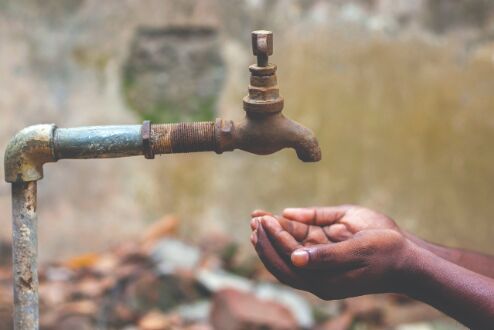A people's movement
Scale of the ‘Jal Jeevan Mission’ necessitates the citizenry of India joining hands with the Government in order to supply water to 18 crore households by 2024

The Ministry of Jal Shakti, Government of India is launching a massive scheme with a huge outlay of Rs 3.60 lakh crore to provide protected water supply to 18 crore households by 2024 with the active involvement of the communities through Panchayati Raj institutions. It is not an easy task to enable the community to participate in the implementation of the new scheme 'Jal Jeevan Mission' as the stakeholders, the people have been oriented to perceive that they are either beneficiaries of a government scheme or petitioners to the government if the benefits are not reaching them. Never have people been conscientised to act as responsible and dignified citizens. Against this background, the new scheme has been announced. Yet the Government of India has determined and committed to making this scheme reality as housing, toilets, electricity, cooking gas, health care, financial inclusion, social security, roads and broadband connectivity schemes implemented. The guidelines for implementation prepared by the Ministry gives hope that it would reach the masses as people have witnessed the water business, water market and water mafia and soar over the way in which the water issues are handled by the state governments so far.
The programme is conceived in such a manner to deliver water supply to the households on a regular basis in adequate quantity and of prescribed quality. It is not a dream but reality as the Government sets certain processes and procedures based on the past experience. There is already an initiative 'Jal Shakti Abhiyan', an intensive campaign in water-stressed districts to harmonise water conservation efforts of all the stakeholders. So far, India has achieved only 20 per cent in providing piped water supply to households. Hence the Government has to ensure 80 per cent in the years to come before 2024. It is to be noted that in a country like India providing water supply to all households on a sustainable basis is not an ordinary task as in India, 256 districts and 1592 blocks are declared as water-stressed. Without the active cooperation of the state governments, local governments, communities, community-based organisations, media and academic institutions, this scheme will not reach the intended goals.
To achieve the target, the Jal Shakti Ministry has prepared the guidelines to operationalise the scheme by providing all safeguards based on the experience in the past while implementing water supply schemes. The scheme adequately recognised the role of Panchayati Raj in implementing the scheme with the active participation of the people. It apparently gives a sense that it is a water supply scheme but in reality, it is more than that. It adequately provides the opportunity to plan for water conservation activities to enable water supply on a sustainable basis. By using the Gram Panchayat Development plan including labour budgeting in MGNREGA, a comprehensive natural resource management plan can be evolved in every gram panchayat with the active support of academic institutions through 'Unnath Bharat Abhiyan 2.0'. A support agency can be created for that purpose to help every village panchayat to implement the scheme. A comprehensive village development plan has to be prepared in which activities can be included to desilt the water bodies available in the panchayats including the inlet and outlet channels to enable the water bodies to get adequate water during the rainy season. Massively water conservation activities have to be carried out through the scheme.
The whole exercise has to be done in such a way that water should be made everybody's business. Since huge money is pumped adequate safeguards are inbuilt in the operational part of the scheme. Money transfer can be tracked at any time. It is interesting that total independence is being given to local bodies to fix levy for water supply. To do all the activities, people have to be mobilised sensitised, conscientised and enabled to participate in the scheme from planning to implementation and auditing socially the same. It is almost a peoples movement and it has to be created to achieve success in the scheme. It is to be noted that in the Kerala transformative process, three movements namely literacy movement, science movement and peoples plan campaign played a significant role in mobilising the people of Kerala for the transformative activities. In the same way, it has to take the shape of a movement for water. If any work takes sacredness into it, it will achieve its goal in India. Hence such a sacredness has to be attached with this scheme as a movement. To do the above media has got a greater role in sensitising the people, NGO's have a role to play as a supportive agency to mobilise people, academic institutions have to play its role as a resource agency to monitor the quality of water and the state government should play its implementation and monitoring role. Apart from the above, the available social capital in every village has to be used to build peoples movement at the grassroots. All have to play their due role synergistically to build a movement for water. It should be made as a sacred activity.
The writer is a former Professor and Rajiv Gandhi Chair for Panchayati Raj Studies, Gandhigram Rural Institute. Views expressed are personal



